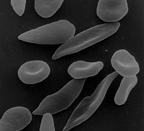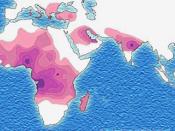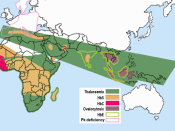Sickle Cell anemia is a group of inherited red blood cell disorders. Normal red blood cells are round like doughnuts, and move through tubes in the body to deliver oxygen. Sickle red blood cells become hard, sticky and shaped like sickles used to cut wheat. When these hard and pointed red cells go through the tubes, they clog the flow of blood and break apart. This can cause pain, damage and a low blood count, or anemia.
A baby will have sickle cell anemia if both the mother and the father are carriers of the gene for sickle cell anemia. A parent can be a carrier of just one copy of the gene and not have the disease. However, if a child inherits a sickle cell trait gene from each parent, the child has two copies of the gene and will have sickle cell anemia.
The red blood cells carry oxygen from your lungs to the rest of your body.
A chemical in the red blood cells called hemoglobin helps the cells carry oxygen. If you have sickle cell anemia, most of your red blood cells contain an abnormal type of hemoglobin called hemoglobin S. This abnormal hemoglobin makes the red blood cells more easily damaged by changes in your body. They may become distorted or be destroyed by a viral infection, a fever, dehydration, a decrease in available oxygen or a change in air pressure, both of which can happen on an airplane.
There are many symptoms for sickle cell anemia and may not experience all of these symptoms. The symptoms include: family history of sickle cell anemia, fatigue, breathlessness, rapid heart rate, delayed growth, susceptibility to infections, attacks of abdominal pain, weakness, joint pain, fever, vomiting, hematuria, excessive thirst, chest pain and...


